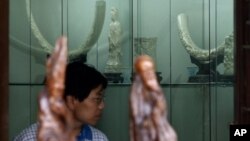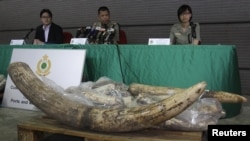BANGKOK —
Asia’s growing class of wealthy professionals is helping fuel the illicit trade in Africa’s endangered species, which experts say is attracting organized crime syndicates of poachers and smugglers hoping to capitalize on the lucrative industry.
Worth $8 billion to $10 billion annually, a large portion of the trade satisfies demands of a large Asian market that value animal parts for traditional medicine and, increasingly, as status symbols.
Although it has no proven health benefits, powdered rhinoceros horn is believed to be an aphrodisiac that also cures cancer. Tiger penis is thought to help sex drive, while the animal's bones are believed to cure arthritis and rheumatism. And animals such as the pangolin, a scaly anteater, are sought both for medicine and meat.
But Steve Galster, director of the Bangkok-based Freeland Foundation, an anti-trafficking organization, notes a recent shift in the consumer demand. Elephant tusks and rhino horn in particular are being purchased for show rather than consumption.
"According to our surveys, [it's predominantly] men between the ages of 25 and 45 who think it's a prestigious thing," he said. "Basically they want to show off that 'I've got this rhino horn; I've got this ivory tusk; I've got this tiger bone' or whatever."
The increased demand for trophies has poachers slaughtering some of Africa's most endangered species at unprecedented rates. This has some conservationists worried that elephants and rhinos could go the way of Asia's wild tiger population, which has dwindled from around 100,000 to a few thousand over the past century. The tigers face possible extinction in the coming decade.
Likewise, African wild rhinos used to number in the hundreds of thousands but there are now less than 30,000. As numerous news reports indicate, thousands of African elephants are poached annually for their ivory tusks.
Some countries are toughening anti-poaching laws, but legislation in many African countries remains lenient and, for many in the trade, the benefits outweigh the costs.
With tusks fetching up to $2,000 per kilo, and comparable amounts of rhino horn commanding up to $50,000, China's black market alone offers global criminal syndicates enormously high profits that entail very low risk of criminal prosecution.
This has turned the trade into a dangerous game.
In the Congo basin alone, poaching gangs have killed roughly 100 wildlife officers in the past decade, according to Doug Goessman, Freeland Foundation's law enforcement advisor.
"When you see a little ivory bauble that you've bought thinking ... it was old or from a legal elephant, no, it's from African elephants," he said. "Somebody may have died so that little piece of jewelry could have made it to Southeast Asia or to China or the United States."
Although anti-poaching laws are gradually getting more restrictive across Asia, Galster said they are still not tough enough to deter smugglers.
"Loopholes and laws need to be closed, particularly in Thailand. Vietnam has some work to do as well," he said. "China has probably the strongest laws in the region."
While trafficking authorities say China is making huge strides to crack down on wildlife smugglers, the country's robust economy, coupled with a population of 1.3 billion, means even a little demand goes a long way. So addressing the consumer base directly, Galster added, is critical.
"We need to change behaviors, [and] that's going to take a while," he said. "In the meantime, frankly, we got to catch the traffickers that are taking advantage of this."
Chinese authorities say they are doing just that.
"In China, currently, the Asian illegal trade in big cats and rhino horn is completely under control," said Wan Zimin, chief of law enforcement and training at China's Endangered Species Import and Export Management Office. "The illegal trade in ivory is reducing [sic] step by step. ... Regarding pangolins, we have also gained control but still need strengthening."
As a traditional consumer and exporter of wildlife, China, Wan added, will always need to satisfy some basic consumer demand. But he said the way that demand is satisfied could evolve.
"There has already been a very big change in perspective," he said, proposing captive breeding as one potential way to undercut illegal trafficking.
Still, a perfect solution remains elusive. Although captive breeding can be effective in meeting demand without killing wild populations, it remains controversial, and some critics say it actually increases demand by allowing the legal sale of rare animal parts.












